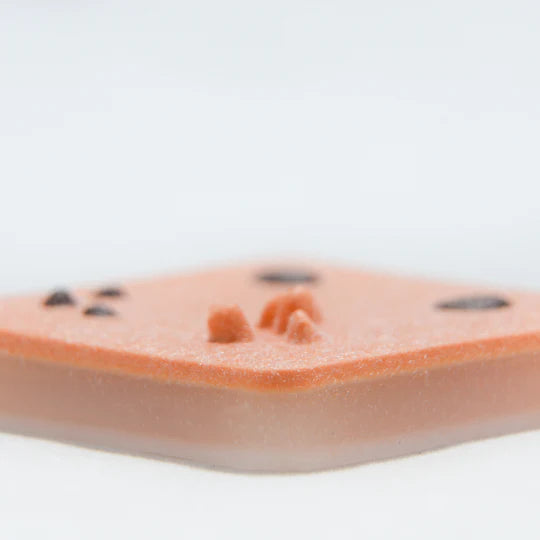
To learn more about our Dermal Lesion Simulated Tissue Pad click here.
WHAT IS A SKIN BIOPSY?
Various skin biopsies are performed to remove cells or obtain skin samples from the patient for laboratory examination. The doctor uses a skin biopsy to diagnose skin conditions or remove abnormal tissue (e.g., actinic keratosis, bullous disorders, skin cancers, inflammatory skin conditions, skin tags, moles, warts, lesions, etc.). Two common types of skin biopsies can be done right in the office or clinic – the shave biopsy and the punch biopsy – and you will likely be assisting or performing these two procedures on your dermatology, family practice, or even general surgery rotations.

HOW ARE THE BIOPSIES PERFORMED?
The procedure starts with tactful exposure of the body part followed by sterile prep of the skin. A local anesthetic is then injected around the skin area to be biopsied. The skin might be marked with a sterile pen to outline the biopsy area.
During a shave biopsy, either a #15 scalpel blade or a tool similar to a razor blade is used to remove a small section of the top layers of skin (epidermis and a portion of the dermis). The depth of the cut varies. A shave biopsy does cause bleeding, but no stitches are needed. Pressure and a topical medication might be applied to stop bleeding.
During a punch biopsy, a circular tool is used to remove a small core of skin (epidermis, dermis, and subcutaneous fat). The tool is held perpendicular to the skin, then pressed down into the lesion, turning clockwise and counterclockwise and advancing until the subcutaneous fat is encountered. The punch biopsy instrument is then removed, again perpendicular to the skin. The specimen is then gently grasped with forceps with care not to crush the tissue (or simply a needle can be used). The specimen is then gently lifted out of the bed and the specimen is cut free just below the dermis. A simple stitch may be needed to close punch biopsy wounds that are 5 mm or larger. A bandage is then placed over the wound to protect it and prevent bleeding.
Therefore, careful technique when performing biopsy procedures is needed to obtain a good specimen, to control bleeding, to minimize discomfort to the patient, and for good healing.
WHICH MATERIALS HAVE BEEN USED FOR PRACTICING SHAVE AND PUNCH BIOPSIES?
Previously, trainees have had to practice biopsies on cadavers or fruits (like oranges, grapes, or bananas). The problem with using cadavers is that the dead skin can be leathery and not truly representative of the consistency of how live human tissue feels. Cadavers are also restricted to a lab setting which limits your practice opportunities. Similarly, the fruit peel on oranges, grapes, and bananas are also unrealistic representations of the texture of skin. As such, training on these poor materials can lead to the development of poor technical habits right from the start. Ultimately, it becomes much more difficult to unteach poor habits than to learn correctly the first time.
SURGIREAL IS THE SOLUTION
Fortunately, SurgiReal has developed a dermal lesion pad that offers multiple opportunities to practice biopsies of life-like skin lesions and different sized moles. Each pad has simulated moles and skin tags that sit atop the epidermis which layers upon the subcutaneous fatty layer and then the fascia layer below that, respectively. The different layers were created in a way that react and respond in the same manner that live human tissue does inreallife. You can actually appreciate the difference in texture at each layer. This realistic tactile experience allows the trainee to develop good technique habits right from the start. The pads also come in light and dark skin tones just to train your eyes on different appearances while performing the procedure. For a separate fee, a disposable biopsy punch can also be purchased in order to gain practice on that type of procedure.
SKILL
Former UCLA basketball coach, John Wooden established his Pyramid of Success as an inspiration and guide for his players to succeed not just in basketball but in all aspects of their lives. The middle block of his Pyramid contains the attribute skill, which he defines as, “A knowledge of and the ability to properly and quickly execute the fundamentals. Be prepared and cover every little detail.” Each of SurgiReal’s specialty pads are uniquely designed for the trainee to develop the fundamental skills required to perform their procedures properly. By having realistic materials to practice these procedures, fundamentals are properly set and student practitioners are given the opportunity to cover every detail when both learning and re-learning.
Former UCLA basketball coach, John Wooden established his Pyramid of Success as an inspiration and guide for his players to succeed not just in basketball but in all aspects of their lives. The middle block of his Pyramid contains the attribute skill, which he defines as, “A knowledge of and the ability to properly and quickly execute the fundamentals. Be prepared and cover every little detail.” Each of SurgiReal’s specialty pads are uniquely designed for the trainee to develop the fundamental skills required to perform their procedures properly. By having realistic materials to practice these procedures, fundamentals are properly set and student practitioners are given the opportunity to cover every detail when both learning and re-learning.
To learn more about our Dermal Lesion Simulated Tissue Pad click here.

